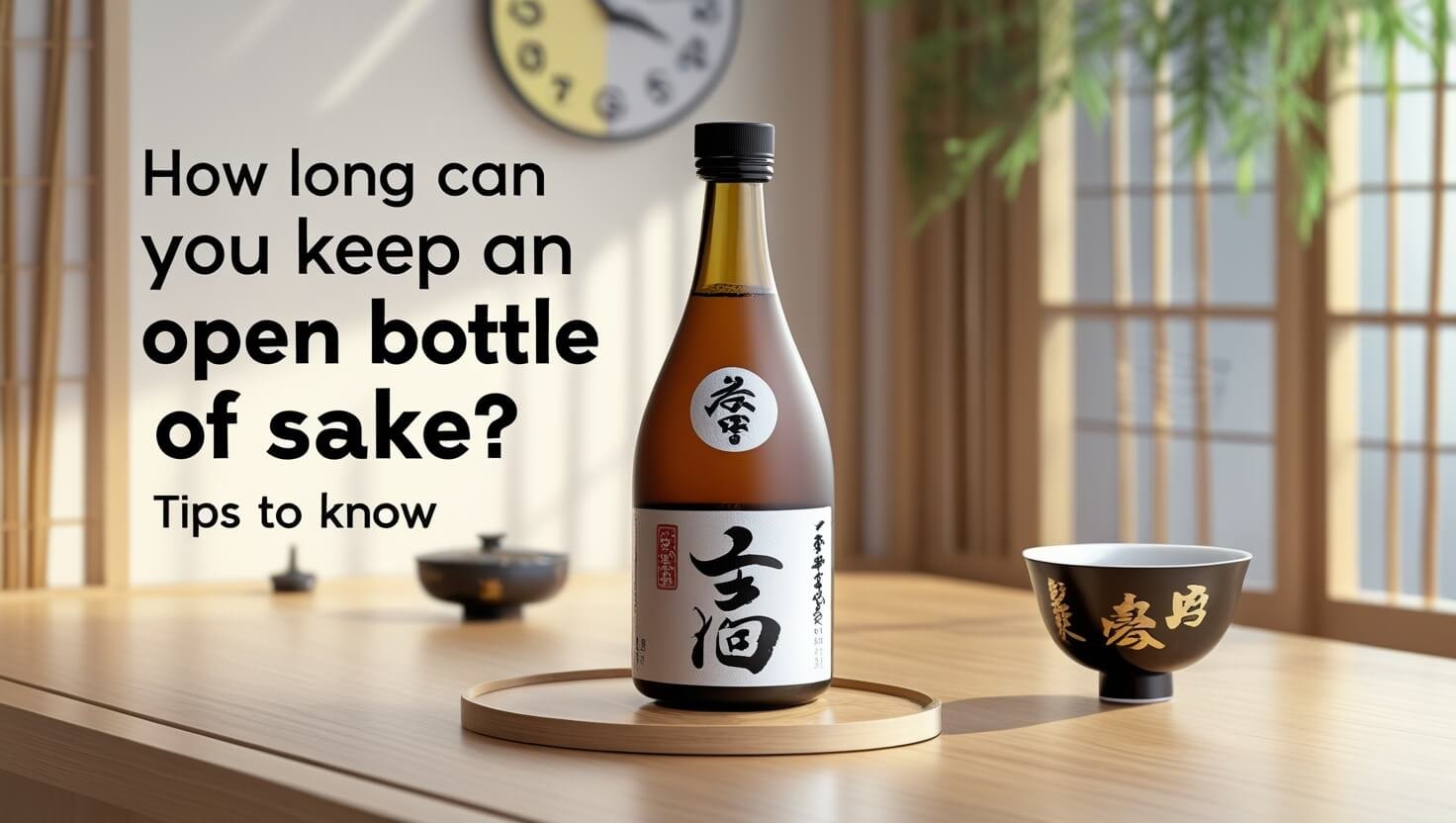How Long Can You Keep An Open Bottle Of Sake? Tips to Know

Many of us wonder how long an open sake bottle stays good. The answer is key to keeping sake’s quality and taste. An opened sake bottle can last 1 to 2 weeks at its best. But, this can change based on oxidation, temperature, and light.
To keep your sake fresh, follow important storage tips. Store opened sake bottles in a cool, dark place. This helps maintain its quality.
Knowing how to store an open sake bottle can extend its life. Understanding what affects sake quality helps preserve its flavor and aroma. So, how long can you keep an open bottle of sake? And what are the best storage tips? Let’s explore the world of sake storage and find out how to keep your sake fresh and tasty.
The Science Behind Sake Preservation
Sake is a delicate drink that needs the right storage to keep its quality and taste. Knowing how to preserve sake involves understanding its chemical makeup and what affects its quality. Sake is usually pasteurized twice before it hits the market. But some types, like Nama-zake, are not pasteurized and need extra care.
Chemical Composition of Sake
Sake is made of water, rice, and tiny living things. To keep sake in top shape, you need to control its temperature, light, and oxygen levels. Keeping sake cool, between 5-15℃/40-60℉, is key to its stability.
Factors Affecting Sake Quality
Things like light, oxygen, and changes in temperature can harm sake’s quality. Light can make sake smell bad, and oxygen can change its color. To keep sake fresh longer, store it in a dark place and seal the bottle after opening. By doing this, you can enjoy your sake for more time.
| Storage Condition | Recommended Temperature |
|---|---|
| General Storage | 5-15℃/40-60℉ |
| Nama-zake and Sparkling Sake | 4℃/40℉ or lower |
| Refrigeration | Below 8°C/46°F |
How Long Can You Keep an Open Bottle of Sake
The shelf life of opened sake depends on several factors. These include the sake type, storage conditions, and personal taste. To keep sake fresh, it’s best to store it in the fridge. This slows down oxidation.
Nama sake, being unpasteurized, should be drunk right away. Other sake types can last a few days to a week or more in the fridge. Using a wine vacuum pump can extend its life up to two weeks when chilled.
Here are some general guidelines for the shelf life of opened sake:
- Unpasteurized sake: 5-7 days in the fridge
- Pasteurized sake: up to 2 weeks in the fridge
- Delicate sakes like ginjo and daiginjo: up to 1 week in the fridge
Quality of sake will decrease over time, even when stored right. So, it’s best to drink it within a few weeks of opening. Proper storage and handling can help preserve your sake’s quality and freshness.
| Type of Sake | Shelf Life | Storage Conditions |
|---|---|---|
| Nama Sake | 5-7 days | Refrigerate at 40°F (4°C) or below |
| Pasteurized Sake | Up to 2 weeks | Refrigerate at 40°F (4°C) or below |
| Ginjo and Daiginjo Sake | Up to 1 week | Refrigerate at 40°F (4°C) or below |
Optimal Storage Temperature Ranges
Storing sake properly is key to keeping it fresh. When you open a sake bottle, it’s important to follow certain guidelines. For short-term storage, keep it cool and away from heat. The fridge is the best place to slow down oxidation.
It’s best to drink Japanese sake within a few days to a week after opening. But, pasteurized sake can last up to a month in the fridge. To keep sake fresh, always close the bottle tightly. Refrigeration helps keep sake fresh, slows down oxidation, and stops microbial growth.
Room Temperature Storage Guidelines
Storing sake at room temperature can cause it to spoil faster. This is because chemical reactions happen quicker at room temperature. If you can’t refrigerate it, keep it in a cool, dark place. This helps protect the taste from sunlight.
Refrigeration Benefits and Methods
Refrigeration is the best way to store open sake bottles. It slows down chemical reactions that affect taste. Wine fridges offer consistent temperature and light protection, which is great for high-end sakes.
Proper storage in the fridge extends sake’s shelf life, preserving its unique flavors and qualities.
Light Exposure Effects on Sake Quality
When you open a sake, light exposure is key to keeping it fresh. UV rays can break down amino acids and vitamins, changing its taste. To protect your sake, store it in a cool, dark spot. This is vital for sake preservation tips to slow down spoilage.
For the best ways to store sake, avoid direct sunlight and use a UV-resistant bottle. This prevents the “sunshine smell” that sunlight can cause. By doing this, you can enjoy your sake longer and better.
Here are some more tips for storing sake:
- Store sake in a cool, dark place, such as a refrigerator or a wine cellar.
- Use a UV-resistant container to prevent light from penetrating the bottle.
- Keep sake away from direct sunlight, specially during peak hours.
Using proper storage methods keeps your sake fresh longer. Preserving opened sake requires care but is worth it.
| Sake Type | Storage Recommendations |
|---|---|
| Nama (unpasteurized sake) | Store in refrigeration at temperatures below 5℃ (41℉) |
| Hiire (pasteurized sake) | Store in a cool, dark place or refrigerate to prolong shelf life |
Proper Sealing Techniques for Open Bottles
Storing open sake bottles right is key to keeping them fresh. Minimizing air exposure is vital to prevent oxidation. The right sealing methods are essential.
Vacuum sealers can remove air from the bottle. This method works best when the bottle is refrigerated. Cold temperatures slow down oxidation. So, keeping the bottle in the fridge and using a vacuum sealer can help it last longer.
Bottle Cap Options
Using a tight-fitting bottle cap is another way to seal open sake bottles. It keeps air out and prevents spoilage. Always store the bottle upright to keep the cap tight.
Vacuum Sealing Methods
Vacuum sealing removes air and stops oxidation. It creates an airtight space that preserves sake quality. This method is great for keeping sake fresh for a longer time.
| Sealing Method | Effectiveness | Ease of Use |
|---|---|---|
| Vacuum Sealing | High | Medium |
| Bottle Cap | Medium | Easy |
Using the right sealing techniques and refrigeration can extend sake’s shelf life. Always handle sake with care and store it in a cool, dark place to keep its quality.
Signs Your Sake Has Gone Bad
To know if sake has spoiled, look at its color, smell, taste, and how it looks. If it smells, tastes, or looks off, it might be bad. Preserving sake after opening is key to keeping it good and fresh.
Bad sake often has a dark yellow or amber color, looks cloudy, or has strange sediment. Its smell might be strong, moldy, or like vinegar. The taste can be rotten or just plain bad. To keep sake fresh, store it in the fridge and use a stopper to seal the bottle.
Here are some tips to spot and deal with bad sake:
- Check the color and appearance of the sake for any signs of spoilage.
- Smell the sake for any unusual or off odors.
- Taste the sake to determine if it has gone bad.
- Store opened sake in the fridge and seal the bottle with a stopper to maintain its shelf life of opened sake.
Knowing the signs of bad sake helps you enjoy it longer and keep it tasting great. Check it before drinking, and if unsure, discard it.
Storage Container Materials and Their Impact
The type of container used for storing sake greatly affects its quality and shelf life. Sake bottles are often tinted dark brown to block UV rays. This helps prevent the sake from aging too quickly. It’s important to choose a container that keeps the sake away from light, air, and temperature changes.
When it comes to sake storage guidelines, the material of the container matters a lot. Glass and ceramic are top choices because they don’t let the sake pick up unwanted flavors or smells. Using the right material helps keep the sake’s delicate flavors and aromas intact, extending its shelf life.
Considerations for Transfer Containers
When moving sake to a new container, think about the material and size. A container that’s too small can let too much air in, causing the sake to oxidize and lose quality. A container that’s too big can dilute the sake, affecting its taste and smell. Picking the right transfer container is key to keeping the sake fresh and flavorful.
Room Temperature vs. Refrigerated Storage
Temperature is key when storing sake. The best storage method depends on the sake type and personal taste. Sake can be kept at room temperature or in the fridge.
Keeping sake at room temperature is good for quick drinking. But, sake is sensitive to light and temperature changes. Sake preservation tips advise storing it in a cool, dark spot to slow taste changes.
Refrigeration is better for longer storage. It slows down oxidation and keeps opened sake quality high. Some sake preservation tips include vacuum sealing to remove air and transferring to smaller bottles.
Here are some key considerations for storing sake:
- Store sake in a cool, dark place to slow down chemical reactions
- Refrigerate sake to slow down oxidation and maintain quality
- Use vacuum sealers to remove excess air from the bottle
- Transfer remaining sake to a smaller bottle to reduce air space
By following these best ways to store sake, you can keep its quality and flavor. This is true whether you store it at room temperature or in the fridge.
Common Storage Mistakes to Avoid
Storing sake correctly is key to keeping its quality and taste. To make sake last longer, follow the right storage tips. When a sake bottle is open, it needs special care to stay good.
Temperature changes are a big worry. They can make sake go bad faster. Keep it cool and dark, away from air. Sunlight and big temperature swings can hurt the sake’s quality.
Temperature Fluctuation Issues
Changes in temperature can ruin sake’s taste and smell. It’s important to keep the sake at a steady temperature.
Air Exposure Problems
Air can also harm sake. Oxidation is a main reason sake goes bad. Use a vacuum sealer or a tight cork to keep air out.
Container Selection Errors
Choosing the right container is also important. Glass or ceramic is best because they keep sake’s flavor and smell safe. Don’t use plastic or metal because they can change the taste.
By avoiding these mistakes, you can keep sake fresh longer. Store it in a cool, dark spot and limit air contact. This way, you can enjoy your sake for more time, whether it’s just opened or new.
Professional Storage Tips from Sake Sommeliers
Sake sommeliers say to keep sake cool and dark to keep it fresh. Ultraviolet rays can harm sake, changing its taste and quality. For types like Ginjo or Daiginjo, refrigerate sake after opening. Their flavors change fast at room temperature.
For the best sake storage, keep it in a cool, stable place. Avoid sudden temperature changes. This is key for Nama sake, which changes flavor quickly after opening. Here are some storage tips for different sake types:
- Ginjo and Daiginjo: refrigerate to preserve delicate flavors
- Junmai and Honjozo: can be stored at room temperature, but refrigeration is recommended after opening
- Nama: refrigerate due to its unpasteurized nature
Follow these tips to keep sake fresh and flavorful. Always handle sake gently, avoiding strong smells and vibrations. Pour it carefully with both hands.
| Type of Sake | Storage Temperature |
|---|---|
| Ginjo and Daiginjo | 40°F-60°F (4°C-15°C) |
| Junmai and Honjozo | 40°F-60°F (4°C-15°C) to 85°F-115°F (29°C-46°C) |
| Nama | 40°F (4°C) |
Different Sake Types and Their Storage Requirements
Storing sake right is key. Proper storage techniques keep sake fresh and flavorful. Keep sake cool and dark to slow down oxidation.
Storing an open sake bottle needs care. Junmai sake should be refrigerated to last longer. Nigori sake, with its cloudy look, needs precise temperature control.
Junmai Sake Storage
Junmai sake is rich and full-bodied. Store it in the fridge to slow down oxidation. This helps keep junmai sake fresh and quality intact.
Nigori Sake Preservation
Nigori sake is delicate and fruity. It needs careful storage. Keep it cool, dark, and away from sunlight to preserve its unique taste.
Sparkling Sake Care
Sparkling sake is lively and bubbly. It needs special care. Store it in the fridge and keep it sealed to keep the fizz.
Knowing how to store different sake types is important. Whether it’s an open bottle or unopened, proper storage keeps sake fresh. This way, you can enjoy your sake at its best.
Ending Thoughts
Exploring how long you can keep an open bottle of sake is key. Proper storage is vital for keeping sake’s flavors fresh. Sake’s complex makeup means it needs careful storage to avoid spoilage.
Whether you like junmai, nigori, or sparkling sake, store them in a cool, dark place. This keeps them away from heat and light. Using the right seal and controlling the temperature can make an open bottle last months. By avoiding common mistakes, you can enjoy sake’s complex aromas and tastes fully.
Sake sommeliers offer valuable tips for storing sake. With the right knowledge, an opened bottle of sake can be a joy for a long time. It’s all about the care and attention you give it.




